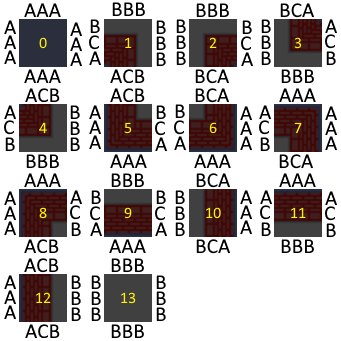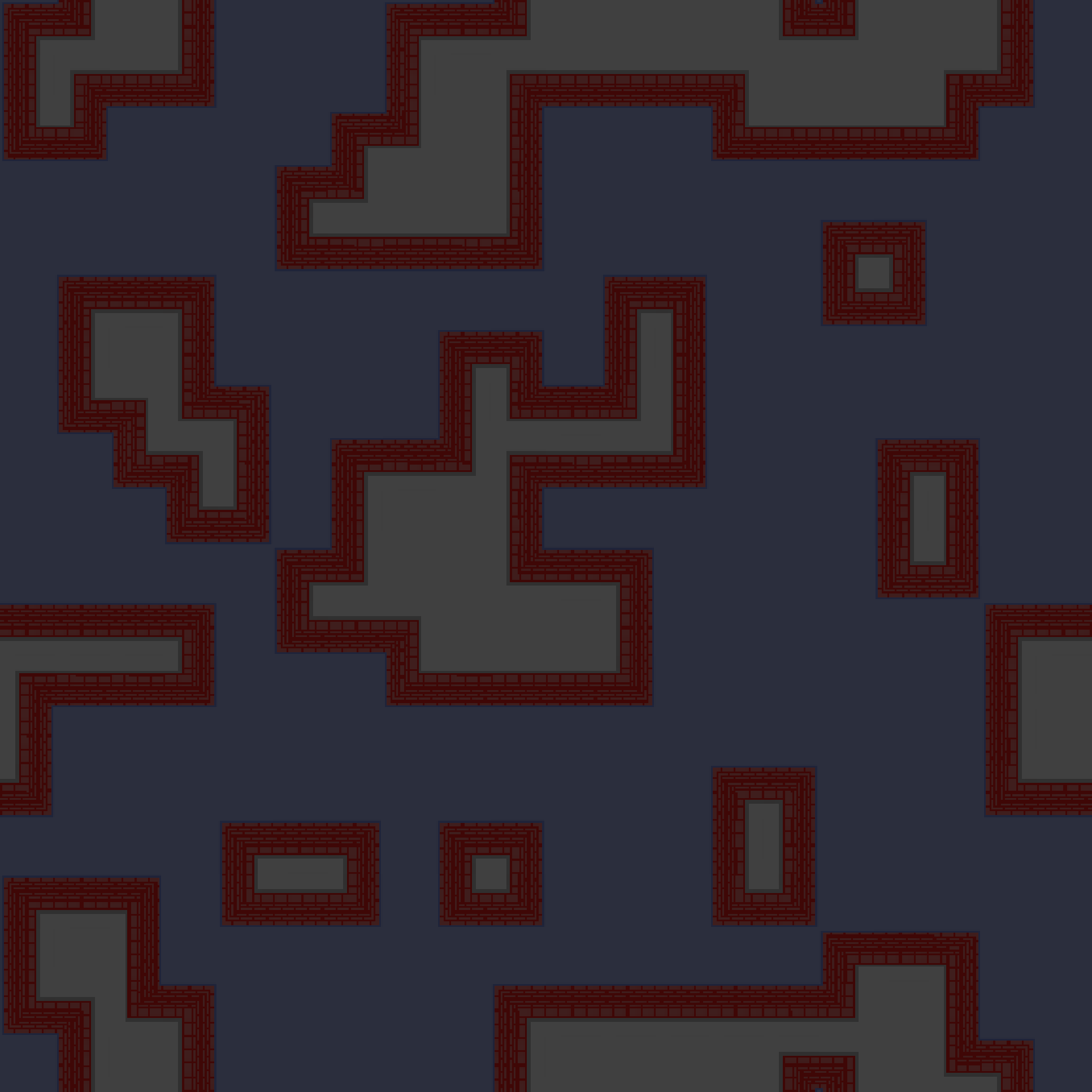A Wave Function Collapse implimentation in JavaScript, focusing on speed and set up for more complex tilesets. Usage is geared towards other rendering programs like Phaser Tilemaps as it returns an array of indexs.
Install BlazinWFC with npm
npm install blazinwfcimport WFC from 'blazinwfc';
import { definition } from 'definition.js';
const wfc = new WFC(definition);const map = wfc.collapse(50); // Collapses a 50x50 grid and returns an array of indexs
wfc.test(50, 10); // Collapses a 50x50 grid 10 times and returns the average time in secondsThe definition is where you define your tiles rules and set some options for the algorithm. Examples can be found in the examples folder. The following is a small snippet of a definition.
export const definition = {
options: {
collapseType: 'normal', //Default 'normal'
saveInterval: 0.02, // Default 0.02
baseWeight: 10, // Default 10
startCell: { // Pick a tile to start on and what to fill it with
cell: 'middle', // Default 'random'. Options: 'middle', 'topLeft', 'topRight', 'bottomLeft', 'bottomRight', 'defined'
cellCoords: { x: 14, y: 14}, // This is only used if you choose the defined option and you can pick any cell you want
index: 0 // The index of the tile you want your starting cell to be
}
},
tiles: [
{ edges: ['AAA', 'AAA', 'AAA', 'AAA'], type: 'floor', exceptions: undefined, weight: 30 },
{ edges: ['BBB', 'BBB', 'BCA', 'ACB'], type: 'wall', exceptions: undefined, weight: 3 },
{ edges: ['BBB', 'BCA', 'ACB', 'BBB'], type: 'wall', exceptions: undefined, weight: 3 },
{ edges: ['BCA', 'ACB', 'BBB', 'BBB'], type: 'wall', exceptions: undefined, weight: 3 },
{ edges: ['ACB', 'BBB', 'BBB', 'BCA'], type: 'wall', exceptions: undefined, weight: 3 },
{ edges: ['ACB', 'BCA', 'AAA', 'AAA'], type: 'wall', exceptions: {down: ['wall'], left: ['wall']}, weight: 5 },
]
}You can leave the options empty for default values to be used but you still have to leave the options property in the object
options:
collapseType: Current options are 'normal' and 'layers'. Default is 'normal' and it can be left out if 'normal' is what you want.
saveInterval: This is used to determine how often a current state should be saved for rolling back the algorithm incase it gets stuck. You can run the test function and mess with this to see if you get faster results with a different percentage (0.02 == 2%). Default is 0.02./
baseWeight: This sets the default weight for tiles where weight is undefined.
numLayers: If you want to do a layered collapse you need to add this property and set it to a number of layers you want.
The tiles property is where you define the tiles to be used by the algorithm. The tiles must be entered in the same order as your tilemap you plan to use. (Images below)
tiles:
edges: You can think of these like sockets, they run in the order UP, RIGHT, DOWN, LEFT.
type: The type of the tile is used by the exceptions object.
exceptions: Sometimes you will run into a situation where tiles have matching sockets but should still not be placed next to each other. For example (See socket map image below) the floor tile can go right of tile 6 and left of tile 8. So all three have 'AAA' socket but tile 8 should not go right of tile 6 so you add wall to tile 6's right exceptions and tile 8's left exceptions.
weight: This is where you can mess around with how high of a chance a tile should have of showing up. Default is 10.
layers:
Right now if you are doing a layered collapse you need to add this property to the definition. It should look like so.
layers: {
0: {
fillTile: 0,
},
1: {
fillTile: 25,
}
}You will need to have a numbered property corresponding to each layer. The fill tile is an index to fill the final maps with. So my layer 0 is my base layer and I chose to fill it with floor tiles. Layer 1 is my layer for the tops of walls so it looks like the player is behind the wall a little, I chose an all alpha tile to fill that with.
post:
This is for selecting what post processing functions you would like to perform on the map after generation
post: {
smallRooms: {
handler: 'fill',
floorIndex: 0,
fillIndex: 1,
alphaIndex: 25
}
}Right now the only option is filling in small rooms (closed off rooms inside wall areas) (only enabled on the angled type definition right now).
smallRooms: This will make the smallRooms process run.
handler: How you would like to handle the small rooms. Only option right now is 'fill'.
floorIndex: The index of the floor tile in the tiles array, this is used by the makeRooms method to find all the sepperate rooms.
fillIndex: This this is the index of the tile you wish to fill the rooms in with. Probably the wall top tile.
alphaIndex: The index of an all alpha tile for replacing tiles on layers above the first.
A closer look
When adding the sockets to your defintion make sure to read in a clockwise direction. Compare the third tile in the above code to the socket map image below. The top socket should be entered left to right, the right socket top to bottom, the bottom socket right to left and the left socket bottom to top.
You can shorten sockets so 'AAA' could be just 'A' while leaving 'BCB' as needed. Watch out though for things like 'BBA' and 'BAA' don't shorten them to 'BA'.
Here is how the tilemap should look for use in phaser if you're using that or another program that uses tilemaps.
A sample generation
There are two example definitions in the examples folder and their corresponding tilemaps in the image folder.
I could only really find one other JavaScript implimentation of WFC https://www.npmjs.com/package/wavefunctioncollapse
I ran speed tests (for a normal collapse) and averaged the time over 1000 map generations of varing sizes. It is important to note that the other implimentation is also working with bitmap data. For the test I did parse out the bitmap loading to only happen once and not on every call to get a more fair comparison to how this one works. I also shutdown processes on my computer that could possibly spool up cpu usage durring a test.
| Test | BlazinWFC | WaveFunctionCollapse |
|---|---|---|
| 25x25 | 0.0048 Sec | 0.0039 Sec |
| 50x50 | 0.0197 Sec | 0.0457 Sec |
| 100x100 | 0.1556 Sec | 0.6778 Sec |
Definitions: This is actually the reason I decided to make this package. With WaveFunctionCollapse I still cannot wrap my mind around how the definition works. I initially got the above example to work after days of bruteforcing it and when I tried to move to the angled tiles I just couldn't get them to work. It also might not be possible with a tile set that is more complex like that. I wanted to make BlazingWFC's definition more verbose and eaiser to understand. I got lucky and found coding trains video on youtube and modified how his works.
Setup: With BlazinWFC you only have to write your definition import the package and then you can call the collapse method. Granted both packages were set up with different purposes but there is no need to set up all the other functions used by WaveFunctionCollapse. The tiles array and their rules are also set to the WFC object as soon as you instaniate it by default instead of creating that data structure every time you want to run it, though you can also set this up yourself with the other library.
Rollback: With BlazinWFC rollback is built in. Sometimes collapsing will end in a contradition. With the other library you have to handle this yourself and the only option is to start over. It is better to rollback to a previously saved state then to start over, especially with bigger maps. More complex maps will contradict more often as well. The rollback feature also allows for some of the speed gains. I was able to forego updating all the cells that should be updated every cycle in exchange for having to rollback more often.
(multi layer example will be added soon)
https://codepen.io/Arkyris/pen/zYmxmWv
- I do hope to make it even faster, if not for smaller maps at least for bigger ones. Suggestions are always welcome.
- Tile symmetry. Just to make definitions shorter.
- Closed off room handling, with the option to either fill them in, open them up or leave them as is for further post processing and creation of hidden rooms. (ie, the walls open up when you inspect them but thats on you)
- The map is designed to be tileable right now (the left and right side can match up as well as top and bottom) if there is a want I will make that optional.
- Multi layer support


